
The Dalmatian Bull belongs to the Prehistoric Era in the Animalario. This species came across the Pacific Ocean to América and eventually melt in with other species. Is quite similar to the bull we all know, but bigger. You can still find many of them in the old continent, especially in Spain and France, as well as in America.
I wrote once to the renowned street stencil artist C215, showing him my stencil works and wondering if he could help me to paint some wall in Paris. He invited me to paint in some kind of a public institution with lots of walls already painted by many artists all over the world. He gave me a tiled wall, and amazingly it is still well preserved! (after 10 years).


The hareagle are hunterpreys, living in many places around the world, in arid and desolate landscapes, away from the green vegetation and humid weather. They are scavengers but good hunters as well.The opposite species also exists in the same habitat, and when they meet they can fight each other for hours.
This wall is the upterrace of my friend Sabotaje al Montaje, in Santa Cruz de Tenerife, Here we were sharing a moment before we left for the Anti Zoo Festival up north the island, in la Laguna.
What happened in Tenerife? link

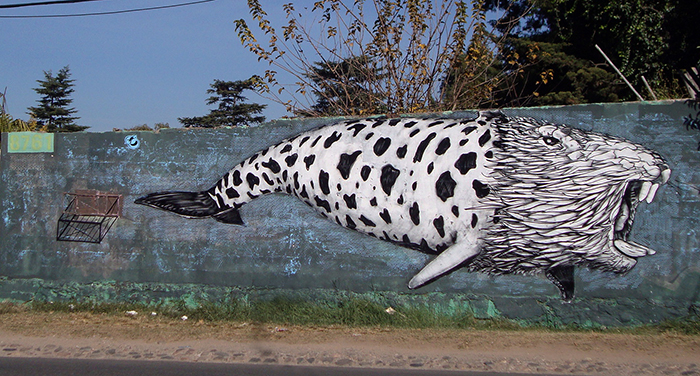
This species is called Shima. It was called like this by the Yamana, the original people of the lands of Ushuaia. Shima means water. In his body, the humpback whale – scientifically known as “yubarta” – and the beaver of southern Argentina meet and coexist. How and why this species originated in Argentina is still a mystery since neither the beaver nor the yurbarta are native to these lands. There are legends and myths that explain his birth but the scientific evidence is not conclusive.
Although Shima was never painted in Ushuaia (the mural of the picture is somewhere in Córdoba), it was discovered when I went to the city of the end of the world to film a docufiction: The Polar Giant. In this short film Shima has an important appearance… We even saw her tail during a boat trip!

It lives underground in the Argentine Northwest (NOA). In the regions of the highest altitude of Argentina. It can be seen in the Pirquitas Mines, mining deposits in the Province of Jujuy. They live in the darkness. They are blind, scavengers and highly dangerous. At the tip of its eight legs it spreads poison to its victims so that they die slowly and alone. Then, when they are already dead, the Spidereagle returns for its food.
This is a species that I painted twice on walls in Buenos Aires and in Córdoba (picture), not yet in the right place though. I would love to travel to northern argentina and leave a wall painted with a Spideagle, where it belongs.
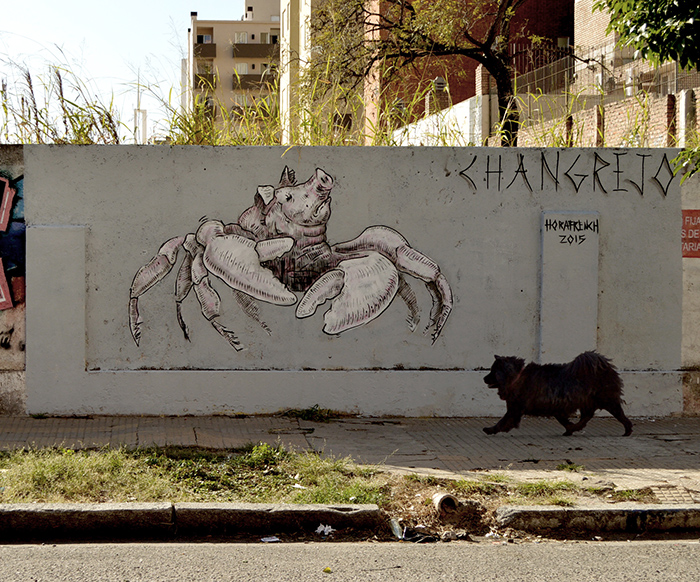
Pigcrabs can be seen throughout many different coasts of the planet. The pigctrabs from the Argentine and Chilean coasts in particular, they resist the cold of the south and the atlantic water. They are funny and can easily be domesticated.
This wall was painted in Barrio Cofico, City of Córdoba, Argentina, in 2015. I have a pigcrab tattooed on my arm, and there also exists a pigcrab made of puppet for the movie Animal Moribus (2017), among others species from the Animalario.


The caimafrog is a prehistoric amphibian. Its habitat is actually in the hot humid steppes of the Province of Corrientes, mostly in the Esteros of Iberá. They are bigger than a usual frog and they are deadly dangerous. The Caimafrog has an alligator jaw and blue arrow frog venom (the famous venom that is used for hunting by the locals of the Amazon of Brazil).
These two walls were painted one in Córdoba City and the other one in Alta Gracia, both in Córdoba Province, Argentina, during the 2017. However, this species has to be painted somewhere near the Amazonas!




Species: acinonyx hippopotamus
It is a violent predator and runs with great speed. It lives in plains and in the humid pampas of South America. It moves in herds, like wild cats. something genuine of this species is that it likes to bathe in water, rare for a feline but necessary for a hippopotamus.
This mural was made for the FESTIVAL DE MURALISTAS LATINOAMERICANOS, in Sesc Ipiranga, in August 2014. It is a family of hypochitas, the father and mother go out worried to meet some wolves (painted by the guest artist Joao Lelo).

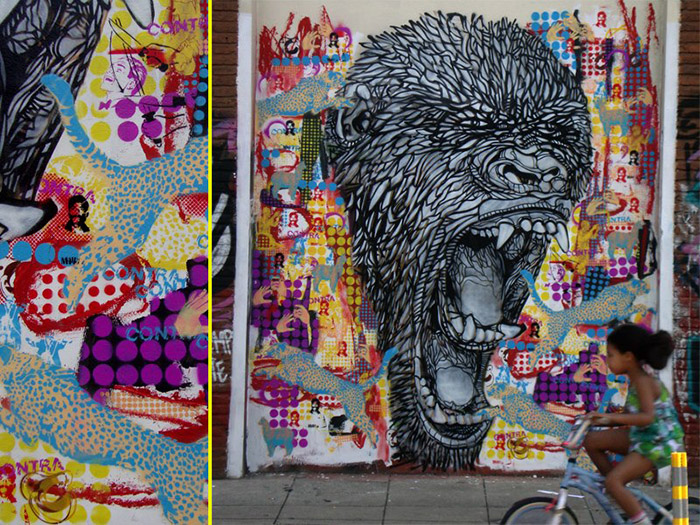
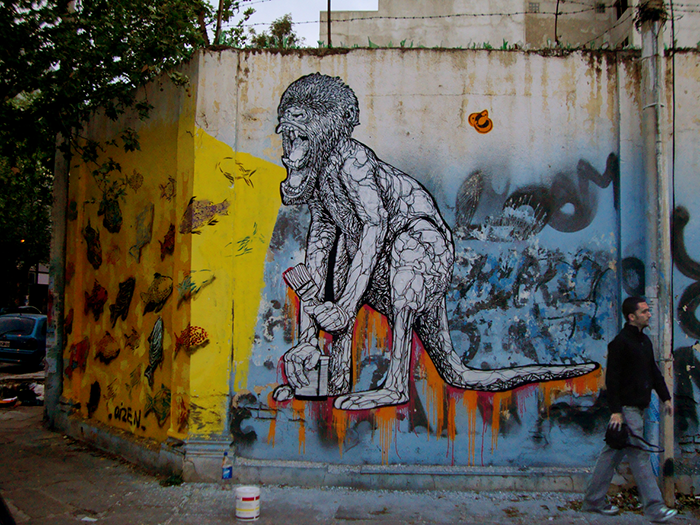
Species: Ateles Marsupialis. Popularly known as «the beast of the mines».
It lives in the mines of Jujuy, province of the Argentine northwest. They are nocturnal and can see very well in the dark. They usually hide in caves in mining areas, deep in the ground, and go hunting outdoors at night. They jump, achieving great speed to hunt. Their hominid arms and hands allow them skill in their tools for working the land.
This mural was painted in the city of Córdoba, although the intention is to paint it in Jujuy. Year 2014, Barrio General Paz, Córdoba, Argentina.



It lives in the Yungas (mountain jungle), an Argentine tropical zone, in the provinces of Tucumán and Salta. This species is a prey hunter. It is the largest feline in the region. He is stealthy and adept at moving between trees. Interestingly, even though it feeds on plants, if you come across one you have little chance of survival.
The deerjaguar is one of the most popular within the Animalario. It has visited the old continent, especially Paris (2019) and several cities in South America, such as Buenos Aires and São Paulo (2014).
What happened in Paris? link


It is a species that moves in large groups. Adults usually reach 2 meters in length. Its textures are very attractive: smooth, striped or stained skin. Their antlers are small, and they have very tender eyes.
Fun Facts. On a trip to Concordia, I watched from the car how swamp deer (as they call them) were running at high speed. The man who was taking me told me that they are not from there but from the other side of the river: Uruguay. I was amazed at their ability to cross a river so deep and wide, and I wondered why they did it. Later, conversing with other locals, I learned that there was a company that brought very important people from all over the world to fish huge surubíes in the area. And that it is actually a spectacular business because there, in the Salto Grande Dam, huge surubíes live 60 meters deep. People just have to throw the hook and take them out.

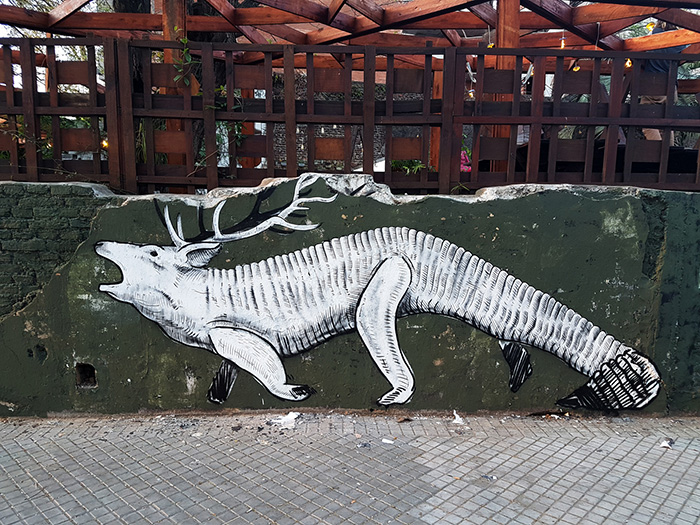
The river Deergator is a ferocious, large animal that moves in herds. They are omnivores: they feed on other fish, small mammals, algae and plants on the banks of the river. They live for many years, it is a species that has survived over time and has a strong ability to survive. It lives in tropical areas of South America, from the Manaus river (Amazonas) to the Chaco, Formosa and Misiones areas.
This particular mural was painted in Rosario, when the city was surprised one day to see a Deergator loitering on the shores of Isla Victoria. They are usually separated from their herd when they die.
Fun Facts 2. A sculpture of a Deergator was made for the Carroussel of “FICCION”, a contemporary art exhibition in the Caraffa Museum, in 2018, Córdoba city, Argentina.

There is a man in the province of San Luis who has dedicated his life to tame horses with the wisdom that the Ranqueles Indians used, which has disappeared over time. He is called Oscar and his job is Indian Taming. No violence or submission of the horse to its tamer. The idea is to get them to stop being savage by using understanding and kindness. Now, taming a liebrallo is the most difficult challenge for Oscar, because its hare body allows it to easily slip and escape from anyone interested. Even when caught, pretending to tame it is challenging the impossible.
I painted this mural in the city of San Luis, in front of a police station and without permission. It was one of the coldest day of the year, I was very well accompanied though!
What happened in San Luis? link


Toroballos are a strange species in the world of the Animalario Cabustra. Both species, bulls and horses, have been brought from the Old Continent and here they have adapted well in humid and pampas areas. They symbolize the force that dominates and submits the weakest. They move in large herds and reach a large size, greater than a medium bull or horse. Females are easily identified because they have the body of a horse with the head of a bull. Males, on the other hand, have an equine body with two heads at the ends (the anus is located next to the testicles). They act like pets. They barricade themselves for long periods in a place that gives them shelter and grass to feed on, until there is nothing left but dung and mud. Few predators could dare attack them.
This mural has been painted in the most important Hippodrome in Córdoba, in La Rural, Casona del Jockey Club, Córdoba. 2018.



They are small monkeys, named after the mane that surrounds their face. Prowlers of the trees and daytime habits, sleep in the cavities of the trees at night, and there they also seek refuge on hot days. Currently this species of monkeys also exists outside the fantastic world of Animalario Cabustra. More precisely in Brazil.
Fun facts. The mural I was painting was near the Museum of Natural Sciences. Once, I went to it and I drew lots of exotic and stuffed animal drawings. I left fascinated. However, what I could not represent in a drawing was what I saw soon after, on my way back to Sesc to continue painting. I felt a shadow pass over me, a bright Brazilian sun, I looked up and there they were, a family of Mico Leao Dourados, silently walking on the light cables. Until I noticed that it was a herd when I saw others on high walls and also very tall trees.



Popularly known as «the River Rat», the Trout Weasel is a species endemic to the mountainous region of Cordoba.
On the one hand, the weasel is a marsupial that has been able to survive against large predators, such as the puma and the deer. On the other hand, the trout is a fish introduced into the country for sport fishing. It destroys the ecosystem because it does not belong in these rivers. The combination of both species is born out of the need for the balance that nature makes: that species that moves from one habitat to another, causing disasters in the process, together with a species that stays alive for generations in the same place.
This mural is located on the bridge at the exit of Cordoba City Airport. Among other species painted there, they advertise to newly arrived tourists about the local fauna.

Blond Corvinas are fish that are abundant in the Rio de la Plata and the Argentinean coast. Like the mammals of the aquatic world, they have to come up for air every now and then. They can jump long distances and can even stay for a long time on the surface. This exposes them to predators, of which there are many. Eaglerats, for example, are encouraged to enter deep water to hunt Seagull bass.
This mural has an excellent location: in front of the Estación de Colectivo, and in front of the Malharro Art School. My colleague Florencia helped me, and a fellow muralist pointed out the wall so that I could paint without problems on the public road. I had to cover up a very laborious mural, and I painted over it because it had been scratched all over, due to vandalism.
What happened in Mar del Plata? link


It is not just any eagle, nor does it come from any fox. The zorráguila species juxtaposes the Aguará Guazú fox, highlighting its large size and enviable reddish fur, along with the Chaco eagle, whose claws get to lift a sheep, although their food is basically snakes, armadillos, rodents. They inhabit arid areas and they can be found all over the southamerican continent.
Fun Facts. The owner of this wall also owns the kiosk at the back side. I asked him for permission to paint a cow and then it was years before I saw him again. He did not recognize me, so I took the opportunity to ask him: what did they paint on the back wall? «Don’t tell me, they made me a horrible flying bat!» Then I said: «I can paint something instead if you want, a better one» And there he recognized me: «You are crazy! Now I love it!». Despite everything, he looked quite satisfied.


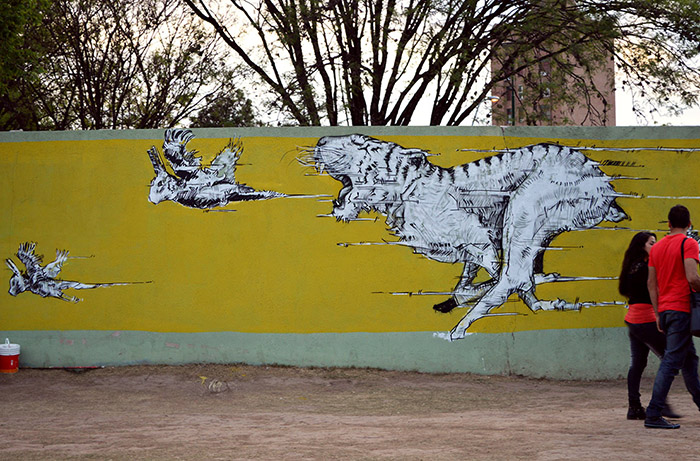
The species is Panthera Tigris Lepus Arcticus and they belong to the group of prey hunters. They are nomads, and they travel over the tropical region of South America, like the Amazonas. Both versions of Haretigers are grouped in their own herds but they also chase each other at a certain distance, and when they get too close, it surely ends in a fight.
Fun facts. This mural is painted in the City of Córdoba, but it should be in a city in Colombia, Venezuela or Brazil.


They belong to the group of hunterpreys and are resistant to the terrible cold winds of the Andes Australes, the southern zone of the Argentine and Chilean Cordillera. Given the climatic conditions where they live, they cannot be appreciated as one would like. They grow to great size, are fast, and when they have a chance to hunt prey, they become carnivores. Although it sounds very attractive to see them, it can become very dangerous if they feel annoying.
This mural was painted on the Sagrada Familia Bridge, in the City of Córdoba, in 2013. However, it should be done in some city somewhere south of the Cordillera, such as San Martín de los Andes or Bariloche.

The owlephant, also called elephowl by their opposites, belong to the group of the Amefricans. In this case, a mix of American owl and African elephant. Both versions of Owlephants always go together, many of them are even couples. They are highly respected animals, not only for their size, but also for their wisdom. They have the quality of being visionaries, and if you come across them (they always go in packs), someone may bless you and share something of your future. They move fast through the northern hemisphere of the South American continent, where it is hottest.
Fan Facts. These two murals are painted in the City of Córdoba, but should be painted in Caracas or Bogotá.


Species known in science as Tigris Piscis. Under water, it is as violent as piranhas, with the difference that they are more solitary and larger. Although they are meat eaters, they are very beautiful and worth seeing. They usually rest in the sun on stones, among the turbulent waters of the Iguazú Falls.
Fun Facts. Interestingly, despite its reproduction on paper or canvas, this species never found an appropriate place for a mural. It is preferable to be in a city like Posadas, near the Iguazú Falls.